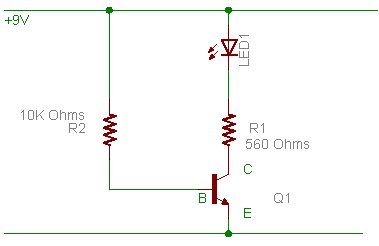figuring out salvaged transistors
you may want to start with teh led tutorial
A transistor will act like two diodes in the following arrangment:

Doing the following continuty tests on the transistor will tell you what type of transistor it is and which pin is the base.
Test
|
Pin 1
|
Pin 2
|
Pin 3
|
A
|
+
|
-
|
|
B
|
-
|
+
|
|
C
|
+
|
|
-
|
D
|
-
|
|
+
|
E
|
|
+
|
-
|
F
|
|
-
|
+
|
Here are the photos of my tests:
Test A:

Test B:

Test C:

Test D:

Test E:

Test F:

Of these tests, only 2 should work. if you only get 1 then you probably have a mosfet.
If any of the following combinations work, you have a bad transistor
A,B
C,D
E,F
Here is how to identify the base pin of the transistor. The other two
pins are the collector and emitter we have to use a different test to
work out which is which.
Tests true
|
Transistor Type
|
Base pin
|
A,C
|
NPN
|
1
|
A,D
|
PNP
|
1
|
A,E
|
NOT A TRANSISTOR
|
|
A,F
|
PNP |
2
|
B,C
|
NOT A TRANSISTOR |
|
B,D
|
NOT A TRANSISTOR
|
|
B,E
|
NPN |
2
|
B,F
|
NOT A TRANSISTOR
|
|
C,E
|
PNP |
3
|
C,F
|
NOT A TRANSISTOR
|
|
D,E
|
NOT A TRANSISTOR
|
|
D,F
|
NPN |
3
|
Of my tests A and C worked. So we now know that we have an NPN transistor and that pin 1 is the base.
How to determine the collecter and emitter of an NPN transistor
Knowing the base, you can do a 'gain test' on the transistor, it will work better if its the right way around.
Wire a circuit up as follows, with a guess as to which is the collected and emitter.

If the LED does not light, reverse your emitter and collector leads. It
should only glow in one direction, if it glows in both, it should glow
more in one direction than the other. The arrangment that gives you the
most glowing is the correct one.
--
the next steps tell you which is the collector and which is the emitter of a pnp transistor, its
not written yet, tell me if you want ot know this and I'll finish it
with you.
Rue







